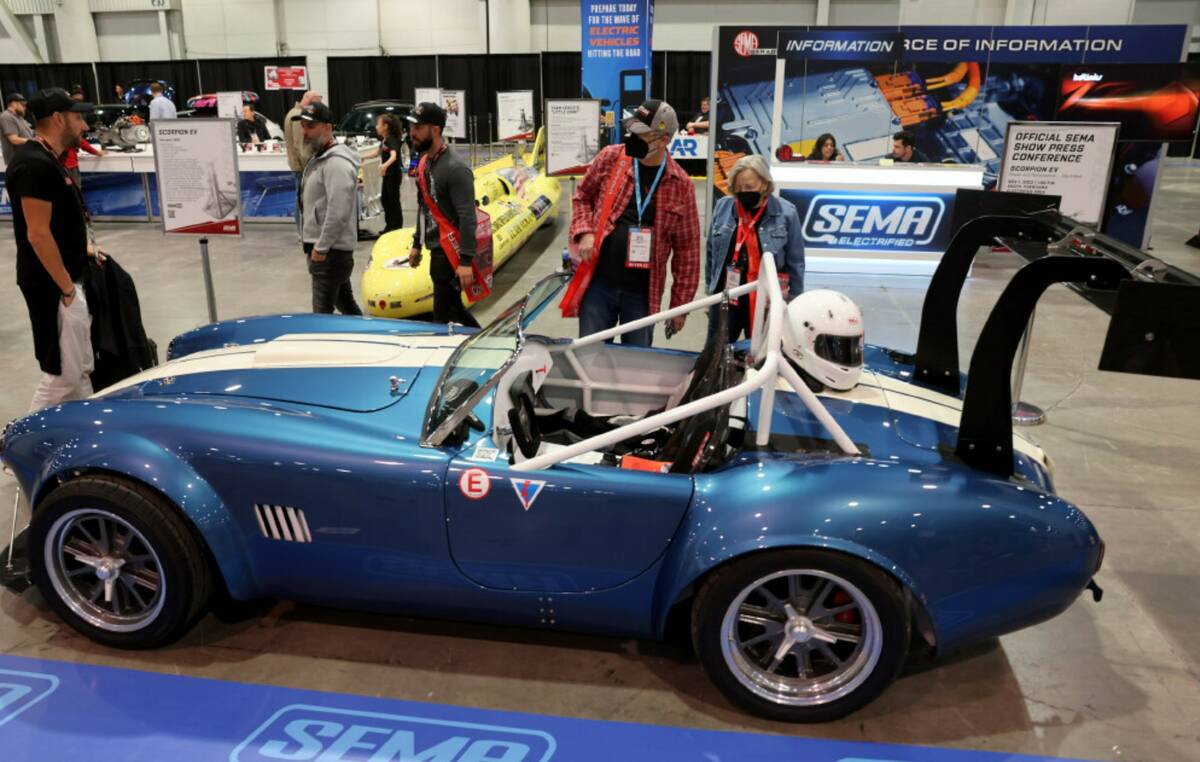EV focus brings big shift to SEMA show

Automakers like General Motors Co. have been shifting their focus toward electric vehicles, and the automotive aftermaket industry have also taken notice.
This year’s Specialty Equipment Market Association show at the Las Vegas Convention Center, which ends Friday, brought back its dedicated space for EVs, labeled “SEMA Electrified,” and it’s 740 percent larger compared to 2019, when it was first debuted.
The 21,000-square-foot show floor includes companies and products in the EV space as well as vehicles that were converted from gas to electric such as a Ford Mustang, Jeep Wrangler and Mercury Cougar, among others.
“While currently representing a small percentage of all vehicles on the road, electric vehicles represent a fast-growing market with huge potential for the aftermarket,” Tom Gattuso, vice president of events for SEMA, said in an email to the Review-Journal.
Atlanta-based Ampere EV was at SEMA Electrified showcasing its EV conversion kit, which can convert almost any vehicle’s internal combustion engine to be powered by electricity, said Andrew Knops, media and design intern at Ampere EV.
“People are impressed with how far EV tech has come in the aftermarket industry,” Knops said. “EVs don’t have to be a black box where people don’t know what’s going on under the hood.”
Christopher Maiwald, founder and CEO of Lectron, said there has been a big shift in the EV market since he launched his EV charging company in 2017.
“Back then the EV market was driven by enthusiasts,” Maiwald said. “Now it’s much more general interest.”
He credits companies like Tesla for creating brand awareness around EVs and, more recently, legacy automakers announcing EV lines and leaning heavily into the market.
Ford Motor Co. announced earlier this year it will spend $50 billion on its EV fleet through 2026 while General Motors announced plans to go all electric by 2035.
Randy Stegall, a mechanic at Mershon’s World of Cars in Springfield, Ohio, said as the market grows so should efforts around education.
“This is the way technology is going,” Stegall said. “It’s probably easier for the younger generation to learn about electric vehicles.”
National investment in EVs
In recent years, there has been massive commitments to EVs both in Nevada and across the country.
Gov. Steve Sisolak announced in August that Nevada applied for $38 million in federal funds to improve the state’s EV charging network over the next five years. He also signed a memorandum of understanding in March to commit Nevada to work with 16 other states and Quebec to have 100 percent of new medium- and heavy-duty vehicles to be zero emission vehicles by 2050.
“The future of transportation is electric,” Sisolak said in a statement in August.
NV Energy also has invested an estimated $484 million towards creating an EV infrastructure, $100 million for its Economic Recovery Transportation Electrification Plan and an additional $384 million for its Transportation Electrification Plan.
Nationally, the passge of the Inflation Reduction Act created a $7,500 federal tax credit for EV buyers on vehicles produced in North America. In total, $135 billion will be invested into the industry, according to the White House.
SEMA estimates that of the 250 million light-duty vehicles in the U.S. just 1 percent or 2.5 million use fuel other than gasoline. It’s estimated that 25 to 30 percent of new car sales will be EV by 2030, and that figure will increase to about 45 to 50 percent by 2035, according to a report from IHS Markit.
Contact Sean Hemmersmeier at shemmersmeier@reviewjournal.com. Follow @seanhemmers34 on Twitter.